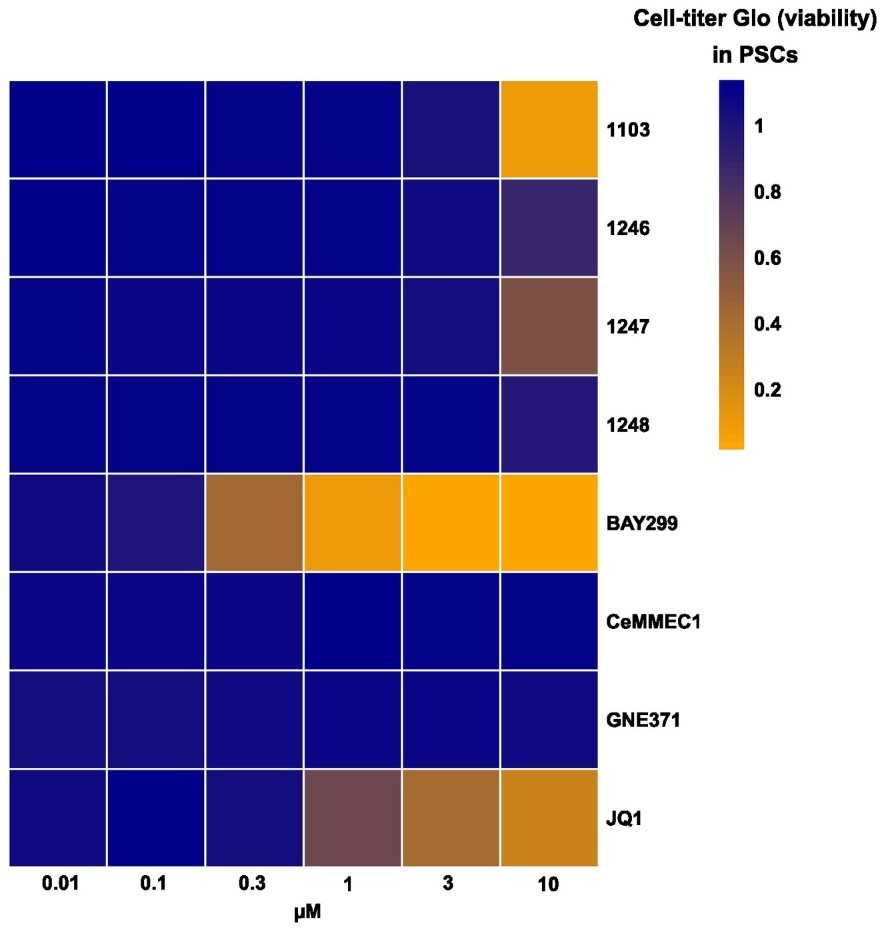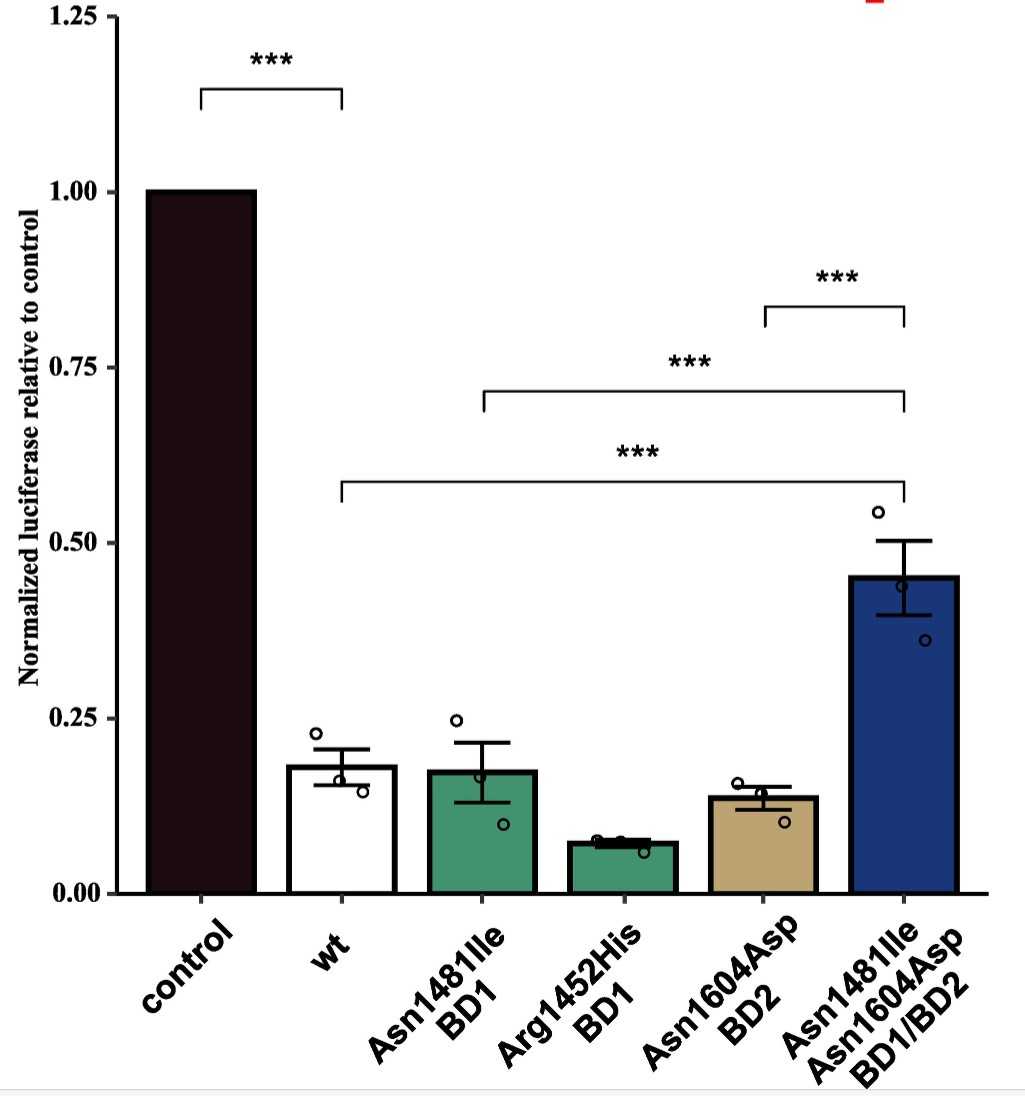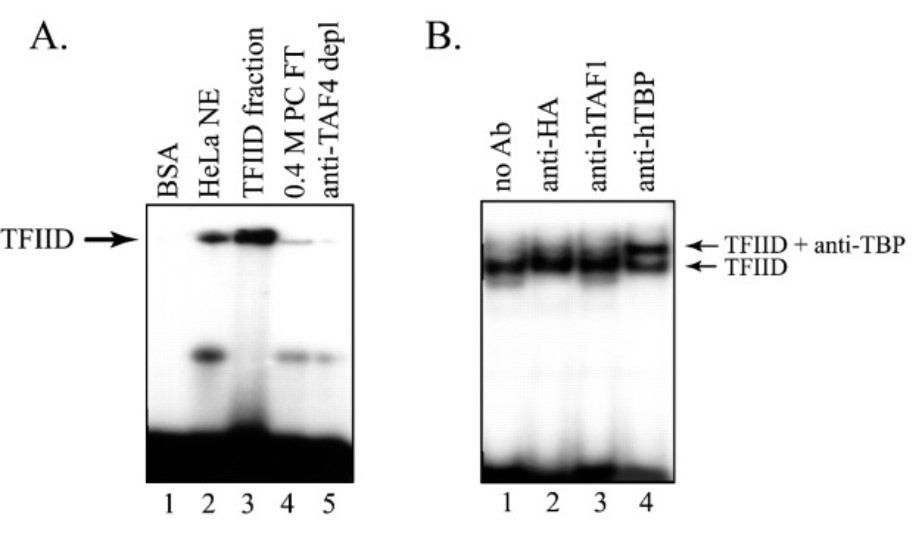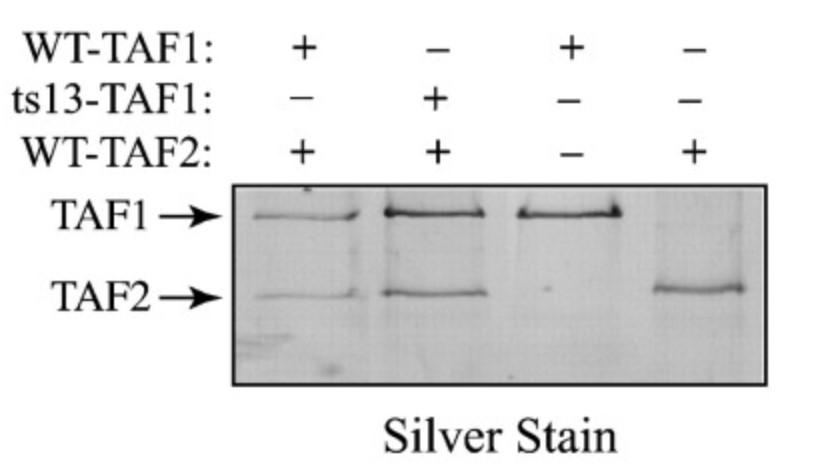TAF1
-
Official Full Name
TAF1 RNA polymerase II, TATA box binding protein (TBP)-associated factor, 250kDa -
Overview
Initiation of transcription by RNA polymerase II requires the activities of more than 70 polypeptides. The protein that coordinates these activities is the basal transcription factor TFIID, which binds to the core promoter to position the polymerase properly, serves as the scaffold for assembly of the remainder of the transcription complex, and acts as a channel for regulatory signals. TFIID is composed of the TATA-binding protein (TBP) and a group of evolutionarily conserved proteins known as TBP-associated factors or TAFs. TAFs may participate in basal transcription, serve as coactivators, function in promoter recognition or modify general transcription factors (GTFs) to facilitate complex assembly and transcription initiation. This gene encodes the largest subunit of TFIID. This subunit binds to core promoter sequences encompassing the transcription start site. It also binds to activators and other transcriptional regulators, and these interactions affect the rate of transcription initiation. This subunit contains two independent protein kinase domains at the N- and C-terminals, but also possesses acetyltransferase activity and can act as a ubiquitin-activating/conjugating enzyme. Mutations in this gene result in Dystonia 3, torsion, X-linked, a dystonia-parkinsonism disorder. Alternative splicing of this gene results in multiple transcript variants. This gene is part of a complex transcription unit (TAF1/DYT3), wherein some transcript variants share exons with TAF1 as well as additional downstream DYT3 exons. [provided by RefSeq, Oct 2013] -
Synonyms
TAF1;TAF1 RNA polymerase II, TATA box binding protein (TBP)-associated factor, 250kDa;OF;XDP;BA2R;CCG1;CCGS;DYT3;KAT4;P250;NSCL2;TAF2A;N-TAF1;TAFII250;DYT3/TAF1;TAFII-250;TAF(II)250;transcription initiation factor TFIID subunit 1;cell cycle gene 1 protein;cell cycle, G1 phase defect;TBP-associated factor 250 kDa;transcription factor TFIID p250 polypeptide;complementation of cell cycle block, G1-to-S
Recombinant Proteins
- Human
- Zebrafish
- E.coli
- Mammalian Cells
- Sf9 Cells
- Flag
- His
- GST
- Non
| Cat.# | Product name | Source (Host) | Species | Tag | Protein Length | Price |
|---|---|---|---|---|---|---|
| TAF1-79H |
Active Recombinant Human TAF1, His&FLAG-tagged
|
E.coli | Human | Flag&His | 1522-1656 a.a. |
|
| TAF1-122H | Recombinant Human TAF1, GST-tagged | E.coli | Human | GST | 1400-1651 a.a. |
|
| TAF1-165H | Recombinant Human TAF1, GST-tagged | E.coli | Human | GST | 1371-1496 a.a. |
|
| TAF1-213H | Recombinant Human TAF1 Protein, GST-tagged | E.coli | Human | GST | 1373-1500 |
|
| TAF1-214H | Recombinant Human TAF1 Protein, His-tagged | E.coli | Human | His | 1373-1500 |
|
| TAF1-215H | Recombinant Human TAF1 Protein, GST-tagged | E.coli | Human | GST | 1502-1635 |
|
| TAF1-216H | Recombinant Human TAF1 Protein, His-tagged | E.coli | Human | His | 1502-1635 |
|
| TAF1-222H | Recombinant Human TAF1 Protein, His-tagged | E.coli | Human | His | 1373-1635 |
|
| TAF1-3927Z | Recombinant Zebrafish TAF1 | Mammalian Cells | Zebrafish | His |
|
|
| TAF1-6954H | Recombinant Human TAF1, GST-tagged | Sf9 Cells | Human | GST | 1032-end a.a. |
|
| TAF1-78H | Recombinant Human TAF1, His&FLAG-tagged | E.coli | Human | Flag&His | 1398-1524 a.a. |
|
| Kit-2032 | TAF1 bromodomain 1 TR-FRET Assay Kit | Non |
|
|||
| Kit-2033 | TAF1 bromodomains 1 and 2 TR-FRET Assay Kit | Non |
|
Background

Fig1. TAF1 working model on AE target genes. (Ye Xu, 2019)
What is TAF1 protein?
TAF1 (TATA-box binding protein associated factor 1) gene is a protein coding gene which situated on the long arm of chromosome X at locus Xq13. This gene encodes the largest subunit of TFIID. This subunit binds to core promoter sequences encompassing the transcription start site. It also binds to activators and other transcriptional regulators, and these interactions affect the rate of transcription initiation. This subunit contains two independent protein kinase domains at the N- and C-terminals, but also possesses acetyltransferase activity and can act as a ubiquitin-activating/conjugating enzyme. The TAF1 protein is consisted of 1893 amino acids and its molecular mass is approximately 214.7 kDa.
What is the function of TAF1 protein?
TAF1 is the largest subunit of the transcription factor TFIID complex and plays a critical role in RNA polymerase II-mediated gene transcription. TAF1 is involved in the transcriptional activation of multiple genes, interacts with multiple transcription factors, and plays a key role in the assembly of the preinitiation complex (PIC). It regulates gene expression by identifying promoter regions and assisting in the localization of polymerase Pol II. In addition, TAF1 has been implicated in neurodevelopment, cell cycle control, and tumorigenesis, and its abnormal function has been associated with certain inherited neurodegenerative diseases and intellectual disabilities.
TAF1 Related Signaling Pathway
TAF1 is the largest subunit of the basic transcription factor TFIID complex, which plays a central role in RNA polymerase II-mediated transcription. Signaling pathways involved in TAF1 include RNA polymerase II transcriptional initiation and promoter clearance processes, as well as regulation of gene expression (transcription). In addition, TAF1 is involved in the regulation of the expression of a variety of cell cycle and apoptosis-related genes, and its abnormal function may be related to the occurrence of some genetic diseases. TAF1 may also be involved in the Wnt/β-catenin signaling pathway, which plays a key role in embryonic development and adult tissue homeostasis, dysregulation of which may contribute to the development of several diseases. By interacting with TBP (TATA binding protein) and other transcription factors, TAF1 is involved in transcriptional regulation, affecting cell growth, differentiation and apoptosis.
TAF1 Related Diseases
TAF1 is associated with several neurological and developmental disorders. Mutations in the TAF1 gene are associated with X-Linked Mental Retardation syndromes (e.g., Mental retardation, X-linked, Syndromic 33, MRXS33), which are characterized by intellectual and motor deficits. In addition, the TAF1 gene has been linked to X-Linked Dystonia 3 (Torsion, X-linked), a neurodegenerative disease characterized by dystonia and Parkinson-like symptoms. The abnormal function of TAF1 may also be related to other pathological processes such as neurodevelopment and tumorigenesis.
Bioapplications of TAF1
First, because of its central role in transcriptional regulation, TAF1 is used as a tool to study the regulatory mechanisms of gene expression. Second, TAF1 is closely associated with the occurrence and development of multiple diseases, making it an important target for the study of diseases such as cancer, neurodegenerative diseases, and metabolic diseases. In addition, abnormal expression or mutation of TAF1 is also associated with certain genetic diseases, so the study of its function can help to develop new diagnostic methods and treatment strategies.
Case Study
Case Study 1: Robert S Leigh, 2023
A combined chemical and genetic approach was employed to identify novel CHD drivers, consisting of chemical screening during pluripotent stem cell (PSC) differentiation, gene expression analyses of native tissues and primary cell culture models, and the in vitro study of damaging missense variants from CHD patients. An epigenetic inhibitor of the TATA-Box Binding Protein Associated Factor 1 (TAF1) bromodomain was uncovered in an unbiased chemical screen for activators of atrial and ventricular fetal myosins in differentiating PSCs, leading to the development of a high affinity inhibitor (5.1 nM) of the TAF1 bromodomain, a component of the TFIID complex. TAF1 bromodomain inhibitors were tested for their effects on stem cell viability and cardiomyocyte differentiation, implicating a role for TAF1 in cardiogenesis. Damaging TAF1 missense variants from CHD patients were studied by mutational analysis of the TAF1 bromodomain, demonstrating a repressive role of TAF1 that can be abrogated by the introduction of damaging bromodomain variants or chemical TAF1 bromodomain inhibition.

Fig1. Effects of TAF1 bromodomain inhibition on mESC viability.

Fig2. Effects of overexpression of TAF1 cDNA with and without damaging variants on the expression of the atrial-specific SMyHC3 promoter.
Case Study 2: Traci L Hilton, 2003
Cyclin D1 is an oncogene that regulates progression through the G(1) phase of the cell cycle. A temperature-sensitive missense mutation in the transcription factor TAF1/TAF(II)250 induces the mutant ts13 cells to arrest in late G(1) by decreasing transcription of cell cycle regulators, including cyclin D1. Here the researchers provide evidence that TAF1 serves two independent functions, one at the core promoter and one at the upstream activating Sp1 sites of the cyclin D1 gene. Using in vivo genomic footprinting, they have identified protein-DNA interactions within the cyclin D1 core promoter that are disrupted upon inactivation of TAF1 in ts13 cells. This 33-bp segment, which they termed the TAF1-dependent element 1 (TDE1), contains an initiation site that displays homology to the consensus motif and is sufficient to confer a requirement for TAF1 function. Electrophoretic mobility shift assays reveal that binding of ts13-TAF1-containing TFIID complexes to the cyclin D1 TDE1 occurs at 25 degrees C but not at 37 degrees C in vitro and involves the initiator element. Temperature-dependent DNA binding activity is also observed for TAF1-TAF2 heterodimers assembled with the ts13 mutant but not the wild-type TAF1 protein.

Fig3. Binding of TFIID to the cyclin D1 TDE1requires TAF1 activity.

Fig4. Assembly of recombinant TAF1-TAF2 dimers.
Involved Pathway
TAF1 involved in several pathways and played different roles in them. We selected most pathways TAF1 participated on our site, such as Basal transcription factors, which may be useful for your reference. Also, other proteins which involved in the same pathway with TAF1 were listed below. Creative BioMart supplied nearly all the proteins listed, you can search them on our site.
| Pathway Name | Pathway Related Protein |
|---|---|
| Basal transcription factors | TAF4B,TAF1L,TAF11,GTF2IRD1,GTF2A1L,TAF7L,GTF2H3,TAF5L,TAF9,GTF2H3-2 |
Protein Function
TAF1 has several biochemical functions, for example, ATP binding,TBP-class protein binding,histone acetyltransferase activity. Some of the functions are cooperated with other proteins, some of the functions could acted by TAF1 itself. We selected most functions TAF1 had, and list some proteins which have the same functions with TAF1. You can find most of the proteins on our site.
| Function | Related Protein |
|---|---|
| histone acetyltransferase activity | CDYL,vnc,METTL8,HTATIP,KAT7A,TAF1L,KAT5,HAT1,NCOA1,CREBBP |
| TBP-class protein binding | PSMC5,BRF1,GTF2A1,PSMC2,TAF1B,EFCAB11,THRA,BRF1B,DR1,PSMC4 |
| transcription factor binding | UBA2,ESRRB,APBB3,DIP2C,TWIST1,HDAC5,PELP1,TCF7L2,RNF19A,DIP2A |
| protein binding | EAF1,USO1,EXOSC7,TGFBR2,HMGN2,PDK3,PARP16,RGS7BP,HIST1H1A,CHCHD6 |
| p53 binding | ZMAT4,RNF34,CREBBP,MDM2,ZNF385B,EHMT2,PLK3,ANKRD1,TP53RK,TRIAP1 |
| sequence-specific DNA binding | RORC,GATAD2AB,LHX9,SP1,SREBF1,NR6A1A,NKX3,CREB3L1,POU3F3A,TRP63 |
| ATP binding | MOK,NLRP5,MCCC2,CDK15,CSNK1G2,CKB,CASKA,DDX39,SGK1,EPHA10 |
| protein serine/threonine kinase activity | ADCK5,CAMKK1B,PINK1,cka1,BSK146,CAMK1GB,TBK1,TSSK2,TLK2,TSSK6 |
| lysine-acetylated histone binding | BRD9,SMARCA4,BRD4,PHIP,BRD2,PSME4B,BAZ1B,ATAD2B,TRIM24,CARM1 |
Interacting Protein
TAF1 has direct interactions with proteins and molecules. Those interactions were detected by several methods such as yeast two hybrid, co-IP, pull-down and so on. We selected proteins and molecules interacted with TAF1 here. Most of them are supplied by our site. Hope this information will be useful for your research of TAF1.
TBP;e1a_ade05;GTF2F1;E2;E2;rpl31_human_gene;rl34_human_gene;rps10_human_gene;RB1;DYSF;DNAJB5
Resources
Research Area
Related Services
Related Products
References
- Sako, W; Morigaki, R; et al. IDENTIFICATION AND LOCALIZATION OF A NEURON-SPECIFIC ISOFORM OF TAF1 IN RAT BRAIN: IMPLICATIONS FOR NEUROPATHOLOGY OF DYT3 DYSTONIA. NEUROSCIENCE 189:100-107(2011).
- Bergstralh, DT; Conti, BJ; et al. Global functional analysis of nucleophosmin in Taxol response, cancer, chromatin regulation, and ribosomal DNA transcription. EXPERIMENTAL CELL RESEARCH 313:65-76(2007).
- Tseng, L; Tang, MY; et al. Progesterone receptor (hPR) upregulates the fibronectin promoter activity in human decidual fibroblasts. DNA AND CELL BIOLOGY 22:633-640(2003).



